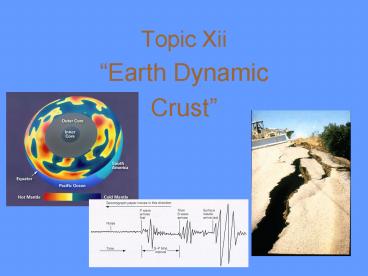PowerPoint PPT Presentation
1 / 25
Title:
1
Topic Xii
- Earth Dynamic
- Crust
2
I. Evidence of Crustal Movement
- A. Original Horizontality assumes that
sedimentary rock is deposited in flat layers. - What causes these layers to shift?
3
B. Types of Crustal Activity
- 1. Faulting cracks within Earths crust.
- 2. Folding bending of rock layers
- 3. Tilting rock layers pushed on an angle.
4
II. Earthquake the vibration or shaking of
earths crust caused by seismic waves.
- A. Types of Seismic Waves
- 1. Primary Waves P waves are compressional
waves that travel fast through both liquids and
solid rock.
5
2. Secondary Waves S waves are shear waves
that travel slowly through solid rock only.
6
III. Earthquake Location
- A. Focus the point below earths surface where
the earthquake originates. - B. Epicenter the point on Earths surface
straight above the focus.
7
C. Calculating Epicenter Distance requires the
difference in arrival times of P and S waves
to a seismic station.
- The further the seismic station is from the
epicenter the greater the difference in arrival
time between the two waves.
8
D. Epicenter Location requires 3 seismic station
readings. Where all 3 intersect is the epicenter.
9
E. Measuring Earthquake Strength
- 1. Mercalli Scale measures the earthquakes
intensity based on the description of the damaged
caused. - larger number indicates greater damage.
10
2. Richter Scale a magnitude scale used to
describe the amount of energy released by an
earthquake.
- a. Each step increase represents an increase of
10 times the next lower number. - Ex. A magnitude 7 is 10 times greater than a 6,
but 100 times greater than a mag. 5.
11
IV. Earths Layers Earth is divided into four
major zones crust, mantle, outer core and inner
core.
- A. Crust lithosphere outer most layer and
relatively thin (10-65 kilometers). - 1. Continental Crust
- thicker
- mostly granite
- low density 2.7 g/cm3
12
2. Oceanic Crustthinmostly basaltmore
dense 3.0 g/cm3
13
B. Mantle located below the crust. Separated
from the crust by the Moho interface.
- 1. Asthenosphere upper mantle flows like a
thick plastic fluid. - 2. Stiffer Mantle thicker and more solid.
14
C. Outer Core made up of liquid iron.
- D. Inner Core made up of solid iron and nickel.
- 1. Meteorites are composed of similar material
(Fe and Ni) as Earths inner core.
15
2. Shadow Zone a dynamic band around Earth that
receives no P or S from an earthquake
epicenter.
- a. S waves are absorbed by the liquid outer
core. - b. P waves are refracted (bent) due to the
different material densities of Earths layers.
16
V. Continental Drift theory proposed by Alfred
Wegener stating that Earths crust is shifting.
- A. Wegeners Evidence
- 1. Continental coastlines fit like a jigsaw
puzzle. - 2. Similar rocks, minerals and fossils found on
separate continents. - 3. Tropical plant fossils found in Antarctica.
17
(No Transcript)
18
VI. Plate Tectonics Theory states that Earths
crust is divided into large plates riding on the
asthenosphere.
- plates can consist of continental crust, oceanic
crust or both. - Ref. Table pg. 5
- Arrows indicate direction of movement.
19
A. Mantle Convection Currents are believed to be
the driving force behind plate movement.
- 1. Hot, less dense magma rises at mid ocean
ridges and pushes plates apart.
20
B. Evidence of Plate Tectonics
- 1. Seafloor Spreading new ocean crust is formed
by rising magma at mid-ocean ridges. - the further from the ridge the older the rock!
21
2. Magnetic Reversals Earths magnetic poles
reverse over time creating a pattern in newly
formed ocean crust.
- magnetic minerals in the new rock align
themselves with Earths magnetic field. - identical magnetic patterns are found on both
sides of the ocean ridge.
22
C. Plate Boundaries the interface between plates
where earthquakes and volcanoes occur.
- 1. Convergent Boundary two plates collide with
each other. - subduction occurs if dense ocean crust collides
with continental crust, creating deep ocean
trenches.
23
2. Divergent Boundary where two plates are
moving apart. Occurs at mid-ocean ridges.
24
3. Transform Boundary two plates slide past each
other. Ex. San Andreas fault
25
4. Hot Spots plumes of hot magma from the mantle
producing volcanoes.
- as a plate moves over the hot spot, chains of
volcanic mountains form. Ex. The Hawaiian
islands.

